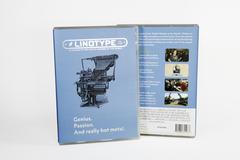‘Linotype, The Film’ gives perspective to technological development (Review Part 2)
There are many facts about Mark Twain that an English and journalism teacher can accumulate over the years –for example, he was born and died on two separate appearances of Hailey’s Comet, 76 years apart, and Samuel Clemens got his pen name from the way a river’s depth is measured for safe navigation.
One fact, however, always comes to mind when I think of Linotype, The Film. Twain lost his early fortune because he invested it in the printing press instead of the telephone. He had a telephone, and couldn’t fathom why it would ever be popular.
He wasn’t alone. According to Imagining the Internet, “President Rutherford B. Hayes (said) to Alexander Graham Bell in 1876 on viewing the telephone for the first time: ‘That’s an amazing invention, but who would ever want to use one of them?’“
Watching the film allows me to understand why the Mississippi River writer so tragically rooted for the printing press — “7 ft. tall, Victorian design” — over its sister invention.
I had watched the film on my own, and thought it wondrously informative and entertaining, with its upbeat music and its focus on the relationship between man and machine. But I’m not always certain I can sell a film’s value to my students. What if they find it boring?
If a film isn’t working in class, it can always be stopped; in this case, it wasn’t necessary. Students begged me to finish it the next day, and their requests went deeper than ones that verge on watching a movie to avoid other types of classwork.
The notes they turned in about the film show the same enthusiasm.
“The main idea of this film is that the linotype revolutionized the printing industry,” Adaira said, after watching the 76-minute film over a two-day class period.
“Brought a new era to journalism. Increased production,” Ryan said.
“The machine only types one line at a time–that’s how it got its name,” Kali said. “I think the main idea is showing this crazy big jump in journalism improvement. This is what helped people begin to print and write more. And now look where we’ve come.”
“The linotype is a symbol of innovation and free speech,” Mekai said.
One of my favorites alludes to revision. Especially in journalism, stories undergo so many rewrites.
“The Linotype machine is a symbol of growth and evolution, because it took multiple attempts to get the Linotype correct and we have evolved in technology from it.”
It certainly shows students who take the Internet for granted how one invention can disrupt and change lives.
Not only did it help me put Mark Twain’s choice into perspective, but the film was interesting to both my journalism and American Literature students. It’s a keeper.




